Timelapse of a Glacier: A Climbing Ranger’s Perspective of Mt Baker
Photos and story by Leif Whittaker
Every weekend when I arrive at a trailhead that I have been to a hundred times before I wonder if I should get a new job. Most climbers would find it monotonous to visit the same ridges, valleys, glaciers, and summits over and over throughout the summer. Admittedly, I often look at the first few steps of a familiar trail and have trouble getting motivated. But after three years on Mount Baker I have learned to appreciate the tiniest details of the seasonal cycle and I believe the mountain is always telling a new story.
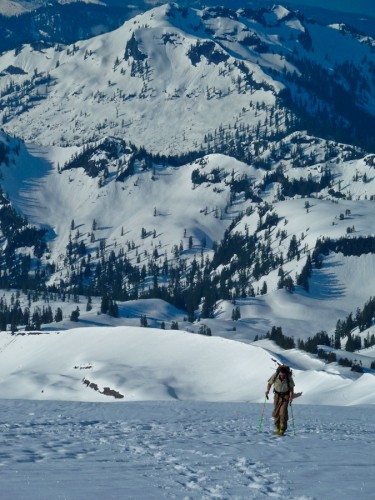
June: Snow stretches to a mile below the trailhead where a few lonely pickups are parked with two wheels in a wet ditch. My skins scuff the waterlogged surface, carving a trail beneath firs and cedars, their lowest branches pinned in drifts. A cold blanket conceals summer. I know when I have reached the glacier because I walked over it last year and the year before, but the signs are not obvious. Meters of rigid corn hide the permanent ice. All but the largest crevasses are invisible. The route is frozen solid. My colleague Brandon’s skins lose purchase on a steep corridor between two crevasses and he slides twenty feet before arresting. The snow shaves off the flesh on three of his fingers, but he says he wants to continue nevertheless. He radios the office to report the icy conditions when we are on the summit. We wait an hour for the sun to do its job and then link arcing turns in sloppy corn all the way to the truck.
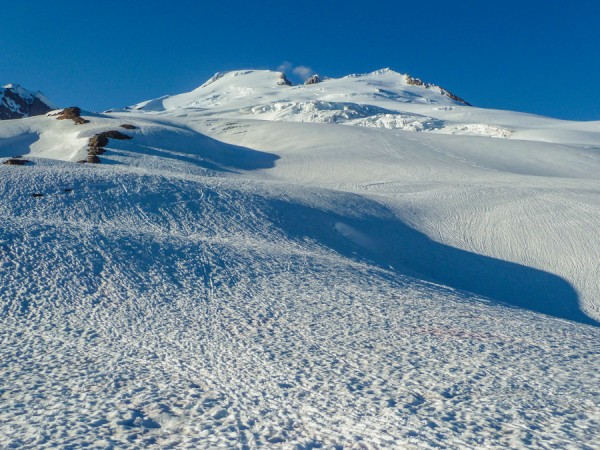
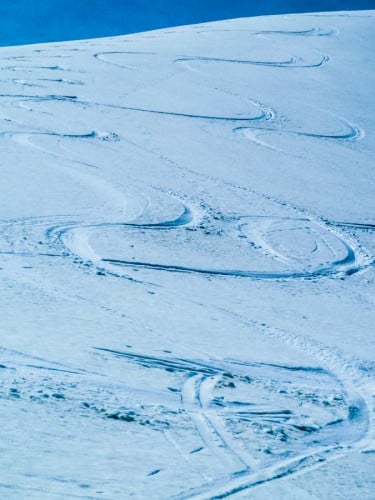
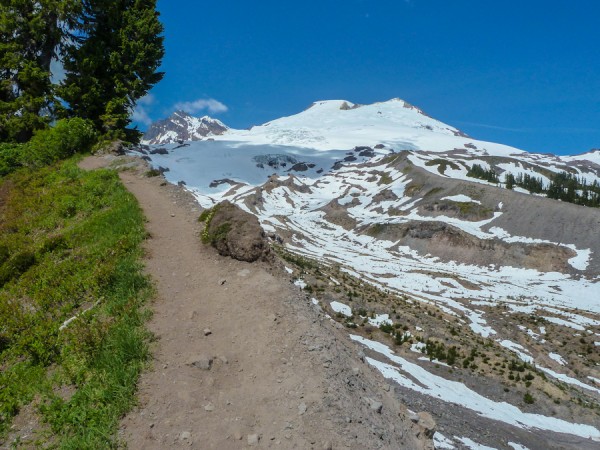
July: The trail crew hasn’t installed the bridge yet and all the guides want to know how the river crossing is. I balance on basketball-sized rocks, submerging my ski boot in turbid water, and jump for the opposite side. The cold blanket of winter is quickly melting away. The knife-edge ridge of the moraine is snow-free—grey dirt interspersed with Partridge foot and saxifrage. A marmot scurries across my path, its tail nodding up and down like a lever. Roped up, we meander around yawning crevasses. A dozen climbers and skiers share the white summit. We wait to descend until they have all gone. Thick clouds sweep across the mountain and visibility drops to nil. Below the crater rim we ski upon a man who needs a rescue. He is balancing on a narrow plug twenty feet below the surface where he landed when he accidentally skied off the lip of a crevasse in the whiteout. The slots on all sides of him are at least 80 feet deep, but somehow he stuck to a plug no larger than a twin bed. He didn’t even lose his skis. Brandon builds anchors and we haul him out with our rope. He thanks us once and glides away. Does he have any clue how lucky he is?
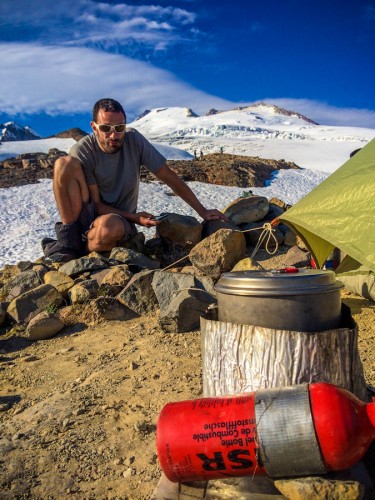
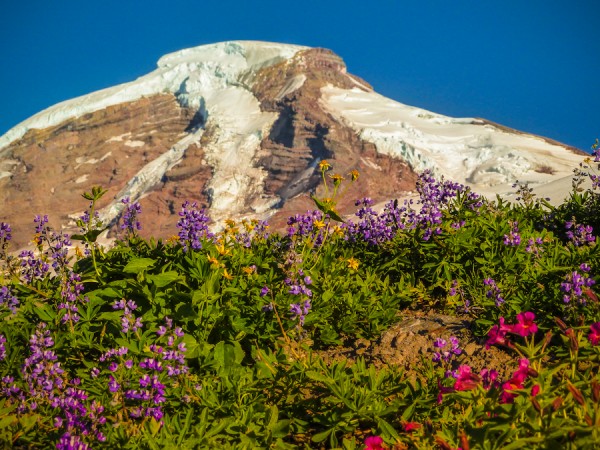
August: The blueberries and wildflowers are out, so the trailhead is clogged with visitors—families with dogs, trains of horseback riders, hunters in neon orange vests, and climbers hefting enormous packs. They say it might get close to 100-degrees in Seattle today. The snow is gone and the foot of the glacier is pure ice the color of a Tahitian lagoon. Veins of milky water run down it, carving parallel ditches. The route is a maze of three-foot-thick snowbridges gapping bottomless cracks. Instead of summiting, Brandon and I spend two days picking up trash—toilet paper, food scraps, wrappers, cigarette butts, snowmobile parts, and “human waste.” We throw it all into 3mm plastic contractor bags. A longtime guide notices our blue nitrile gloves and asks what we are doing. We tell him we like to keep our mountain clean. By the end of the weekend the contractor bags weigh at least thirty pounds apiece. We tie them to the outsides of our packs and hobble to the trailhead. Later that evening the guide writes a letter to the Forest Service. He commends us for “truly caring about the mountain.” Reading the letter helps dull the ache in my knees and back.
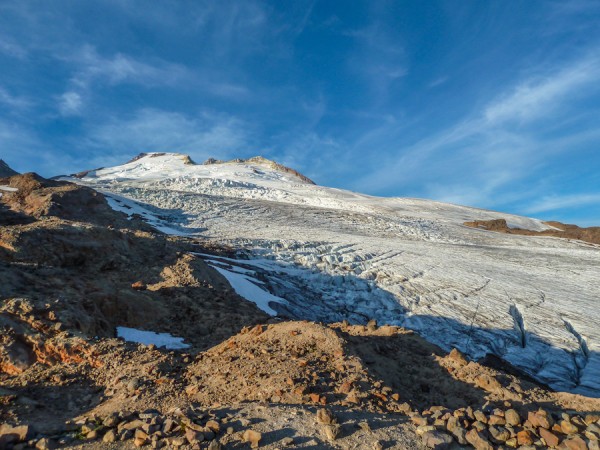
September: Amanita, bolete, russula, and chanterelle sprout from the moss beneath huckleberry bushes. It’s a good thing winter is returning because the mountain is wasting away. The creeks that were once rushing torrents are now mere trickles. All afternoon I listen to the distant rumble of seracs calving off the foot of the glacier. The climbing route travels over narrow fins of ice, bridges no wider than doorways, and crevasses as dark as a cemetery at night. The summit is a pile of dirt with a dilapidated steel box on top. Brandon and I write our names in the annual register for the tenth time. I try to imagine what this place will look like in February after 20 feet of snow have fallen. What will it look like in 10 years? The mountain will be telling a different story then. On our way down the trail Brandon and I dismantle the bridge and hide the parts amongst the tree trunks where winter will bury them until the cycle begins again. I can see Mount Baker from Highway 542. It gleams brilliantly in afternoon sunlight and I am surprised to discover that I am looking forward to the next time I come back.
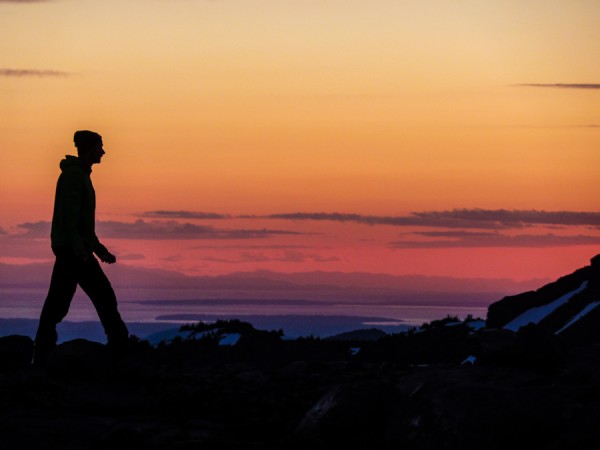
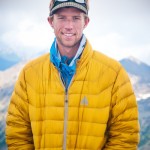 Leif Whittaker seeks adventure in all aspects of life. He is a young and accomplished mountaineer who has twice climbed to the summit of Mount Everest. He is also a talented writer and public speaker who inspires others to enjoy the outdoors. His love of skiing, rock climbing, sailing, kayaking, rafting, hiking, photography, and food has led him to explore many remote corners of the planet. He is currently working on a book about his experiences on Mount Everest.
Leif Whittaker seeks adventure in all aspects of life. He is a young and accomplished mountaineer who has twice climbed to the summit of Mount Everest. He is also a talented writer and public speaker who inspires others to enjoy the outdoors. His love of skiing, rock climbing, sailing, kayaking, rafting, hiking, photography, and food has led him to explore many remote corners of the planet. He is currently working on a book about his experiences on Mount Everest.
